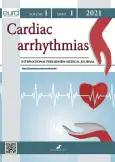Late Electrode Sepsis: Clinical Features, Diagnostics and Management. Clinical Cases
- Authors: Zimina V.Y.1, Airapetian G.2, Grishkin Y.N3, Sayganov S.A.1
-
Affiliations:
- North-Western State Medical University named after I.I. Mechnikov
- Pokrovskaya Hospital of Saint Petersburg
- North-Western State Medical University named after I.I. Mechniko
- Issue: Vol 1, No 1 (2021)
- Pages: 25-32
- Section: Case reports
- URL: https://journals.rcsi.science/cardar/article/view/71367
- DOI: https://doi.org/10.17816/cardar71367
- ID: 71367
Cite item
Abstract
Modern cardiology is impossible without implantation of intracardiac devices, such as cardiac pacemakers, resynchronization therapy devices, implantable cardioverter-defibrillators. Meanwhile, as the number of implanted devices increases, so does the number of cases of their infection [1]. At present, sufficient clinical material has been accumulated, demonstrating the obvious features of the course of this type of IE, leading to late diagnosis, the spread of infection to the tricuspid valve and, as a result, to a poor prognosis. The frequency of purulent complications after implantation of pacemakers is from 0.6 to 5.7%; mortality rate varies from 0.13% in local purulent inflammation to 19.9% in bacterial endocarditis and sepsis [2].
Abroad, term electrode sepsis is widely used to reflect the main features of the course of cardiac implantable electronic device infection, which are the predominance of systemic inflammation symptoms and the long-term absence of heart damage signs.
We present two typical cases of the course of cardiac implantable electronic device infection, illustrating the difficulties of diagnosing and treating this disease.
Full Text
##article.viewOnOriginalSite##About the authors
Vera Y. Zimina
North-Western State Medical University named after I.I. Mechnikov
Email: ziminavu@mail.ru
ORCID iD: 0000-0002-5655-8981
SPIN-code: 7202-1071
Candidate of Sciences in Medicine, Associate Professor
Russian Federation, Saint PetersburgGevorg Airapetian
Pokrovskaya Hospital of Saint Petersburg
Email: goshabravo@mail.ru
SPIN-code: 9102-1759
Saint Petersburg
Yuri N Grishkin
North-Western State Medical University named after I.I. Mechniko
Author for correspondence.
Email: yurigrishkin@yandex.ru
SPIN-code: 9997-2073
Russian Federation
Sergey A. Sayganov
North-Western State Medical University named after I.I. Mechnikov
Email: sergey.sayganov@szgmu.ru
ORCID iD: 0000-0001-8325-1937
SPIN-code: 2174-6400
Doctor of Medical Sciences, Professor
Russian Federation, Saint PetersburgReferences
- Habib G, Lancellotti P, Antunes MJ, et al. 2015 ESC Guidelines for the management of infective endocarditis: The Task Force for the Management of Infective Endocarditis of the European Society of Cardiology. Eur Heart J. 2015;36(44):3075–3128. doi: 10.1093/eurheartj/ehv319
- Sazhin AV, Tyagunov AE, Murman MV. Treatment of suppurative complications of constant pacing. Russian Journal of Thoracic and Cardiovascular Surgery. 2012;(1):31–36. (In Russ.).
- Prokhvatilov GI, Shelkovskii VN. Chronic odontogenic infection and its role in the development of diseases of internal organs (infective endocarditis). Lecture. Saint Petersburg: Military medical academy of S.M. Kirov; 2010. (In Russ.).
- Shelkovskii VN. Surgical debridement of foci of odontogenic infection in treatment and prevention of infective endocarditis [dissertation]. Saint Petersburg; 1999. (In Russ.).
- Krutova SN. Features of dental preparation of patients with infective endocarditis for heart surgery [dissertation]. Tver; 2010. (In Russ.).
- Klug D, Balde M, Pavin D, et al. Risk factors related to infections of implanted pacemakers and cardioverter — defibrillators: result of a large prospective study. Circulation. 2007;116:1349–1355. doi: 10.1161/CIRCULATIONAHA.106.678664
- Kalinin DA, Mikhaylov EN, Ryzhkova DV, et al. Difficult diagnosis of sepsis associated with pacemaker lead , infection in the elderly: the role of positron emission tomography. Journal of Arrhythmology. 2019;26(2):55–57. doi: 10.35336/VA-2019-2-55-57. (In Russ.).
- Gupalo EM, Stukalova OV, Mironova NA, et al. Potentialities of heart MRI in detection of inflammation in patients with idiopathic abnormalities of cardiac conduction and clinical syndrome of dilated cardiomyopathy. Journal of Arrhythmology. 2014;(77):32–41. (In Russ.).
Supplementary files














